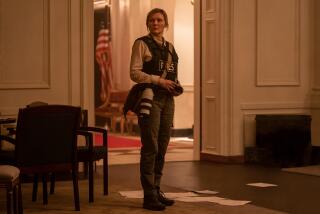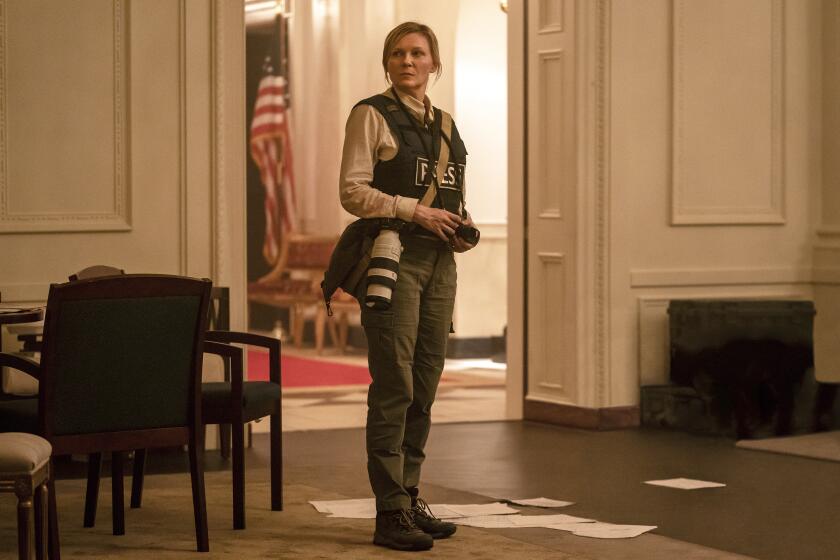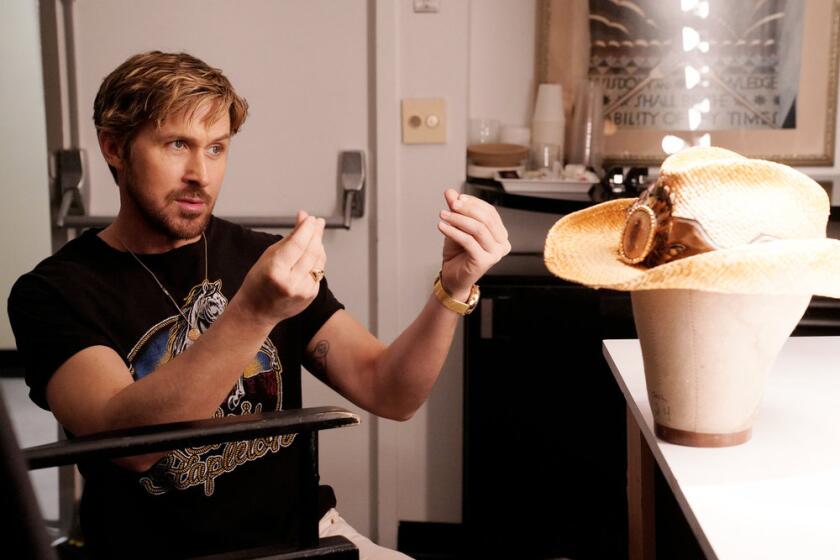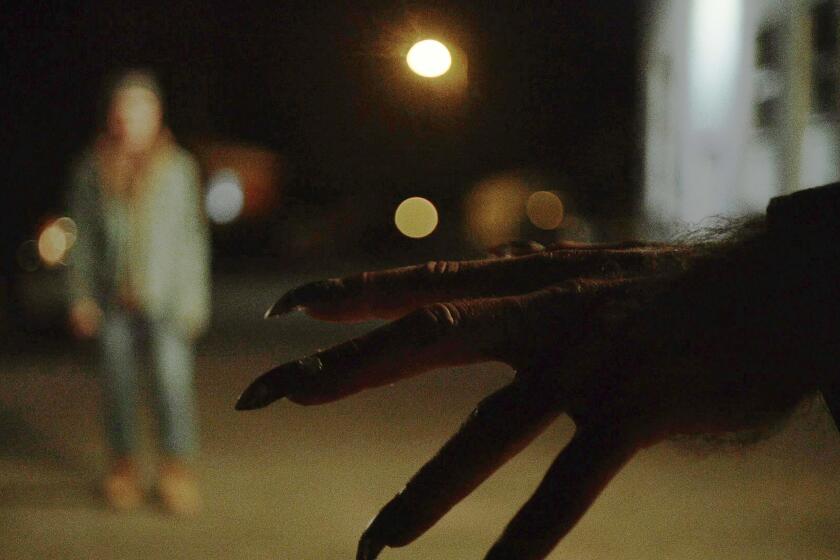Klimt’s tiny flecks of truth
ONCE deemed pornographic, Gustav Klimt’s golden, mosaic-like paintings of sensuous women and ecstatic couples are no longer shocking. But for writer-director Raúl Ruiz, they offer a window into a pivotal time in history.
In “Klimt,” opening Friday, Ruiz evokes the paintings’ shimmering surfaces and delves beneath them to capture the opulence and uncertainty of early 20th century Vienna. Starring John Malkovich as Klimt, the film begins as the artist is dying of syphilis in 1918 and proceeds in hallucinatory fashion through the last 18 years of his life. Ruiz, 66, who has made more than 50 films in the last 20 years in Chile and Europe, firmly established himself as a cinematic maverick with his use of nonlinear storytelling, dramatic color effects and unexpected points of view, and his work here is inspired by the fragmented, circular narratives of Austrian writer Arthur Schnitzler -- a Klimt contemporary. In other words, it’s not the usual biopic.
Ruiz describes the film as a fantasy. “Klimt is dying. He remembers his life, but it’s maybe not exactly his life. . . he was wondering what should be his life.”
What emerges is a portrait of a successful yet conflicted painter whose challenging, psychologically complex work embodied the birth of the modern era. Yet he was, says Ruiz, “the opposite of the revolutionary artists that we see all the time in cinema. He’s not a revolutionary artist in the sense of Picasso . . . that tried to destroy and create new forms. He [was] trying to make connections.” (He definitely connected with the art world after his death: Last year, his 1907 portrait of Austrian socialite Adele Bloch-Bauer fetched $135 million, unseating a Picasso for the highest published price for a work of art sold at public auction.)
The Klimt conjured by Ruiz is an artist caught between the lure of commercial success and his creative freedom. Pulled by opposing forces in his personal life as well, he lived with long-term partner, Emilie Flöge (played by German actress Veronica Ferres) for many years while indulging in myriad affairs, most often with his models. Although it is not depicted in the film, Ruiz learned in his research that when Klimt died, 40 people came forward claiming to be his heirs.
“He’s not a moral icon,” says Ruiz. “He’s far from that, but he has something that I like: the way he tried to make his work as best as he can, knowing that he will go inside of all kinds of contradictions.”
Ruiz sees Klimt’s embrace of opposites as a reflection of the world around him. In the wake of the Industrial Revolution, Europe was modernizing at a rapid pace, with dramatic changes in every aspect of society. For those in Klimt’s circle, it was a time of incredible wealth, luxury and licentiousness, but with World War I looming, it also felt like the last gasp of a golden era.
Ruiz says he wanted to give the film, which opened in Europe last year to mixed reviews, a sense of this desperation. The war is represented in several scenes by a wild-eyed character in uniform who repeatedly disrupts the mannered, refined surfaces of Klimt’s reverie by shouting, “News from the front!” Layering those worlds, Ruiz says, let him explore the idea of “the invention of new forms in art and the destruction of old forms, at the same moment that something horrible is coming.”
It was his vision of Klimt as an ambivalent icon of the early modern era that inspired Ruiz to make the film. “Everything was happening in Vienna,” he says, “Freud, the innovation in music, it was a great period in Europe.”
Fractured imagery
Ruiz’s fascination with that time, he says, “came from my childhood in Chile, where so many Viennese artists escaped from Europe during the second World War. Vienna was. . . something very important for a Chilean in the ‘40s and ‘50s.” Many of the émigrés that he encountered as a boy were Jewish artists, and he recalls that his mother and her friends read Austrian authors such as novelist Stefan Zweig. “There was something mysterious about the deep sense of defeat in the Austrians, and I saw something of that in the Klimt paintings. I tried to create this universe, this pictorial atmosphere of the painting,” he says.
To evoke the golden, swirling surfaces of Klimt’s images, he used a range of low-tech effects including some that the artist used to create his own fractured imagery. One scene opens with rippling reflections of naked women in a pool of water; it soon becomes clear that the pool and the women -- who are swinging from the ceiling in makeshift hammocks -- are set up inside Klimt’s studio.
Other effects directly mimic the look of the paintings. In one scene, Ferres suddenly appears with gold leaf on her lips as the background palpates with misty, golden patterns. A heated argument in a cafe is shot on a turntable so that the actors are spinning around the room. And in one extravagant party scene, groups of guests, shot from the waist up, glide back and forth on wheeled platforms set on rails.
To eyes accustomed to computer-generated imagery, these devices may appear old-fashioned, but for Ruiz, they heighten the film’s emotional impact. “I am reluctant to [use] post-production effects, so I try to make everything during the shooting,” he says, “There is something magic. . . when everything is happening at the same time.”
This interest in immediacy and simultaneous action also influences the way Ruiz works with his cast. “He has a lot of trust in his actors,” says Malkovich, who has worked with Ruiz on previous films. “He sort of watches them as if it were a surprise that . . . they showed up in this room, on this particular day, in this particular century and said these particular things. And he maybe wonders why they did that.”
What Malkovich describes as Ruiz’s “poetic” approach is what initially fascinated him about the director. “In the first film I did with him I just wanted to know if I came in a certain door or not,” he says, “He responded by telling me the story of why the plane tree loses its bark in June, and I thought, ‘Oh God, there’s a director for me.’ He just isn’t interested in responding to a direct question; I love that.”
It was Ruiz’s involvement in the film that persuaded Malkovich, who had previously turned down the role, to sign on to the project.
Ruiz, who lives in Paris, wrote the original screenplay in French. It was then translated into German, and from German into English. He initially wanted to shoot the film in German, but the Austrian producer, Dieter Pochlatko, needed a star like Malkovich to secure international funding.
“It was a kind of a sad thing because when you play in another language you [lose] a lot of your energy,” he says of Malkovich’s European costars. But he did see a similarity between his own dilemma and the political situation in the Austrian empire of Klimt’s time. “It’s a metaphor of the Viennese empire,” he says. “There were something like 60 million people coming from everywhere who were forced to speak German, as now so many people are forced to speak English.”
Ruiz is no stranger to the political and social issues that come with compulsory migration. A committed leftist, he was forced to flee Chile when the Marxist government of Salvador Allende fell in a fascist coup in 1973. Since then, he has carved out a career that balances commercial viability with devotion to his artistic vision.
He is perhaps best known in the U.S. for his 1999 feature film “Le Temps retrouvé” (“Time Regained”), a similarly impressionistic portrait of French author Marcel Proust that was nominated for the Golden Palm at the Cannes Film Festival. His first feature film, “Tres tristes tigres” (“Three Sad Tigers”) from 1968, was a cornerstone of the short-lived Chilean “new wave.”
It’s not hard to understand how Ruiz might feel an artistic and political affinity with Klimt, who also walked a wavering line between commercial success and adventurous artistic expression. “To be an artist is always a very complicated thing,” Ruiz says. “The situation of Klimt. . . is the situation of the filmmaker in our times. . . who tries to escape the dictatorship of [the] market. . . tries to make his way, [and] at the same time not to forget about the market.”
More to Read
Only good movies
Get the Indie Focus newsletter, Mark Olsen's weekly guide to the world of cinema.
You may occasionally receive promotional content from the Los Angeles Times.






